There are millions of blog posts, articles, and videos across the internet that try to give you advice about marketing. According to Google, at least 7,050,000 unique content pieces include the phrase “marketing tips.”
But with plenty of outdated and filler content creation to just build out a website, it’s hard to find applicable advice that actually works online.
In this article, you’ll learn from marketing case study examples that demonstrate what it takes to master channels like social media, email marketing, and PPC, as well as how to use case studies in your own campaigns.
Don’t rely on empty words. Learn powerful marketing best practices that are backed up with examples and data.
What is a marketing case study?
In marketing, a case study is an in-depth study of the effectiveness of a certain tool, tactic, or strategy. It focuses on measurable outcomes, like an increase in sales, visitors, or production hours.
Typically, it includes a few key elements:
- Introduction to the customer/client
- The problem the client needed to solve (should align with problems prospective clients also need to solve)
- The solution (and context of why your company/software was the right fit)
- Data from before and after implementing the solution

In a sense, a case study documents the journey of working with your company. And it gives potential future customers a reason to trust your company.
What are the different types of case studies in marketing?
In marketing, three main types of case studies are commonly used:
1. Third-person or client case studies: These highlight the experience of a specific client working with your company or using your product.
2. Explanatory case studies: These case studies explore the impact of a phenomenon or tactic, such as the company’s marketing strategy, and how it impacted its growth. In this case, it’s not based on first-hand experience, but rather observation and inference.
3. Implementation case studies: An implementation case study takes the average client case study a bit further, focusing on the actual implementation and covering it in detail.
You can also divide the case studies further by the type of medium they use — video or text.
And in 2024, video case studies are becoming more and more popular. Many companies even use them as remarketing ads to address potential objections.
Why should you use case studies?
Case studies are a powerful way to prove that your products or services work, showcase your expertise, and build trust with potential customers.
It’s a way to transition away from just “telling” your customers and instead start “showing” them through examples. There’s a reason the old copywriting maxim goes, “Show, don’t tell.”
Consumers’ trust in companies to tell the truth in advertising materials is lower than ever. In 2020, only 14% of consumers said they trust advertising to be honest about a product or service.
But that doesn’t mean you can’t generate trust with your company’s website.
Consumers trust third-party reviews, testimonials, and data. In fact, 91% of 18–34-year-olds trust online reviews as much as personal recommendations.
So you need social proof. And client case studies — especially those that interview the current clients — are the best of both worlds. You get to highlight data while getting powerful social proof that shows that your product works.
When just adding a simple customer testimonial to your website can increase conversion rates by up to 34%, imagine what a detailed, compelling case study can do.
1. Email marketing case study: Your Therapy Source
If you think that email is a marketing medium of the past, think again. At ActiveCampaign, we have hundreds of recent case studies that prove the opposite.
For example, Your Therapy Source receives a 2000% return on investment (ROI) from our campaigns simply by taking advantage of basic marketing automation.
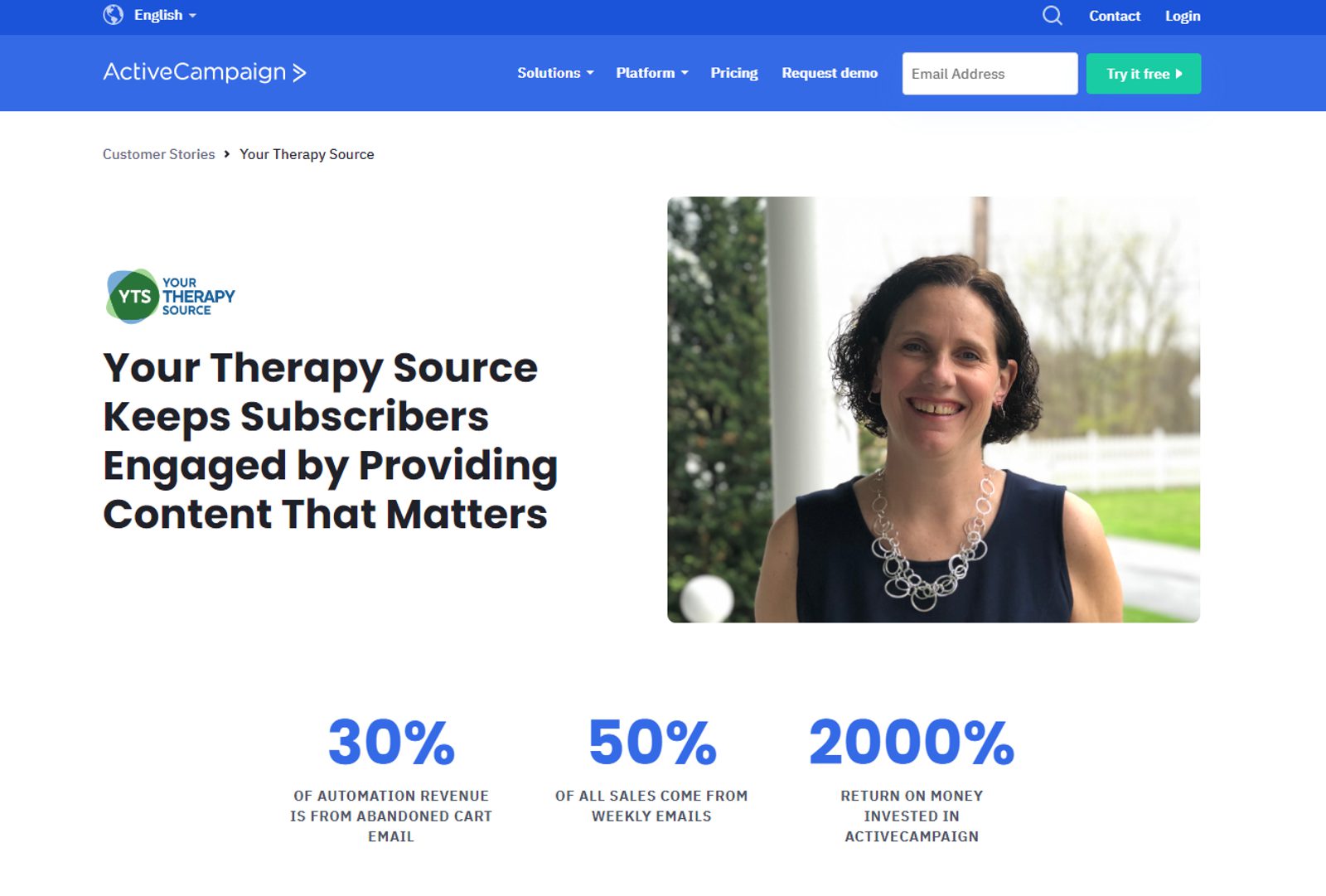
In particular, a basic abandoned cart email represents around 30% of all revenue generated by automations.
With ActiveCampaign, that’s incredibly easy to set up. You can take advantage of our integrations with key e-commerce platforms like WooCommerce, Shopify, and more.

Because the case study goes into detail about exactly how the company achieved the results, it’s a combination of an implementation case study and a regular third-person case study.
2. Instagram marketing case study: Converse
If you look at all the top Instagram accounts in clothing, Converse has a much higher engagement rate than its competitors.
At 1.79%, their social media posts have an organic engagement rate over 15 times higher than Nike.
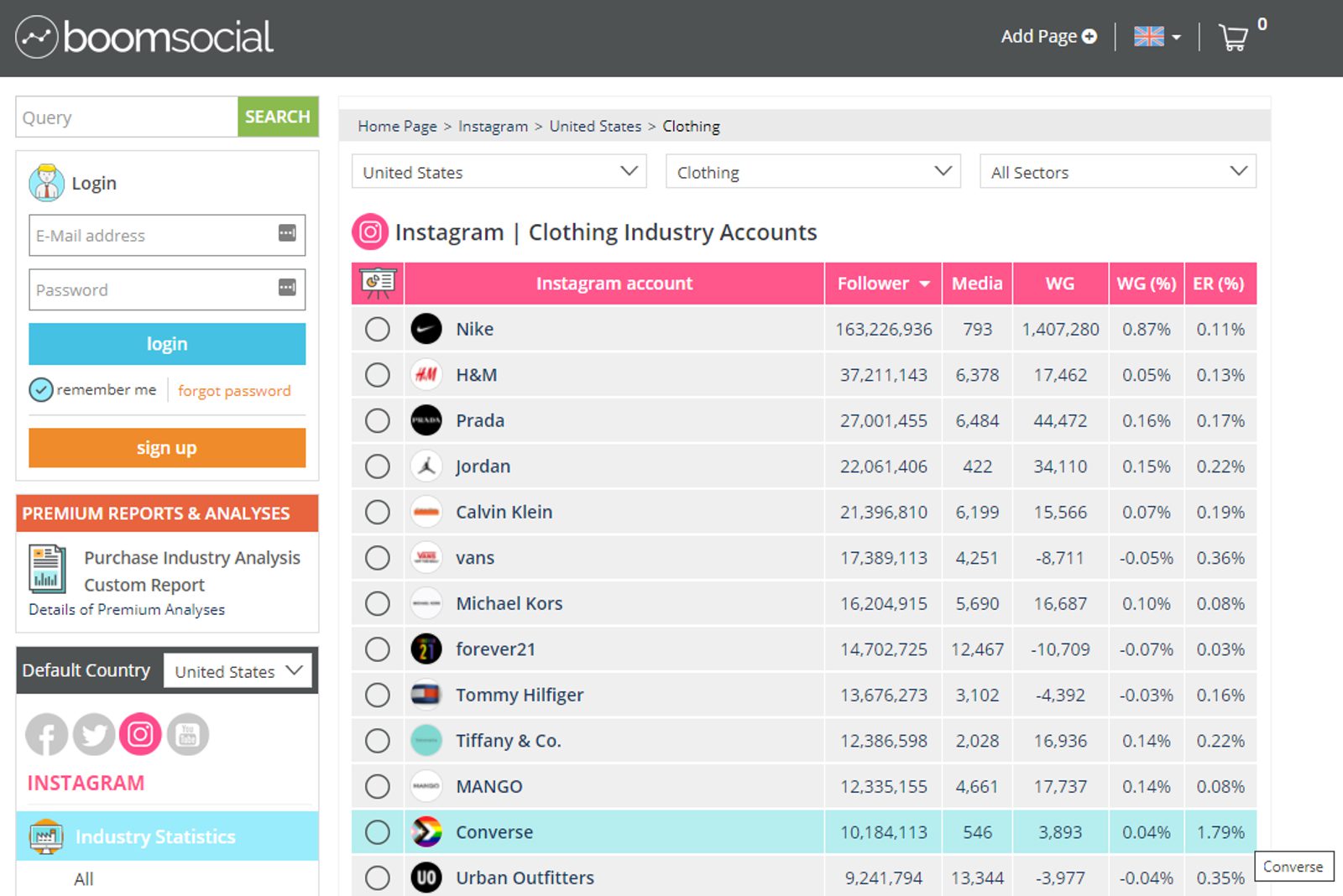
Why is that?
Let’s take a closer look at how they achieve these numbers:
When looking at Converse’s top Instagram posts, you quickly notice a trend. Collaborations with influential creators and artists — lately Tyler, the Creator — get a different level of engagement.

The post promoting their new collaboration shoe got over 183,000 likes in a few weeks. Converse even took it a step further and produced a short film with Tyler.
If you want to reach a wider number of people, combining audiences is a great strategy.

This is an example of an explanatory case study.
First, we worked backward from Converse’s powerful Instagram results. Then, we identified tactics that contribute to their high levels of engagement.
Because we didn’t work directly with Converse, and we’re only observing as an outsider, this is an explanatory case study.
3. Content marketing case study: porch.com
Fractl is a content marketing agency that worked with porch.com for over a year to earn 931 unique domain links, 23,000 monthly organic visits, and more.
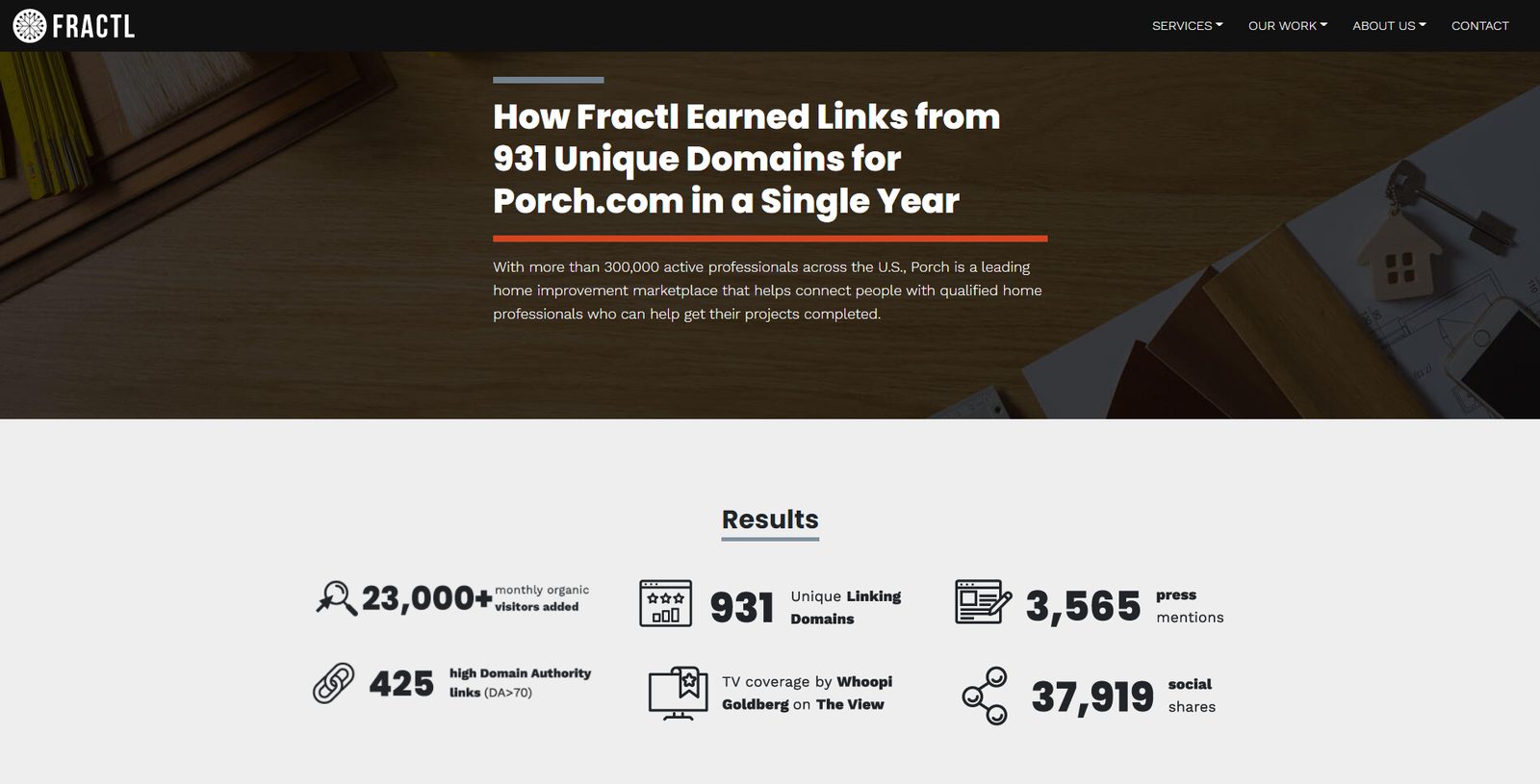
The case study focuses on results over method — that means it’s a typical third-person case study.
They’re showcasing the results the company generated for a specific outside client without getting into the how-to.
These types of case studies are most useful for persuading hesitant potential customers to get on board. Showing that you’ve generated results for similar companies or people in the past is the best way to prove your skill set.
Depending on your target audience, going into detail with an implementation case study may be a better option.
4. SEO case study: Zapier study by Ryan Berg
This in-depth case study by Ryan Berg is a perfect example of how you can use explanatory case studies in your marketing.
It breaks down Zapier’s SEO strategy and how they created over 25,000 unique landing pages to improve their search rankings for different search terms.

Zapier’s main strategy revolves around targeting relevant long-tail keywords like “app A + app B integration.” That’s the key they used to generate serious organic traffic over the long term.
By breaking down industry leaders and how they rose to success, you can borrow some of their brand power and credibility.
You can use these kinds of case studies if your current clients don’t allow you to go into detail about the tactics you use to grow their online presence.
These case studies demonstrate to potential clients that you know what you’re talking about and have the expertise needed to help them succeed in their industry.
5. PPC case study: Google Ads and Saraf Furniture
When it comes to pay-per-click (PPC) advertising, Google was one of the earliest innovators. And in 2021, it’s still the largest digital advertiser globally, with $146.92 billion in ad revenue in 2020.
You might not think they need any more credibility, but Google still uses case studies, especially in emerging markets like India.
This case study shows how Google Ads helped Saraf Furniture generate 10 times more inbound leads each month and hire 1,500 new carpenters as a result.

Without going into details about the methods, it’s another typical third-person case study designed to build trust.
6. Video marketing case study: L’Oréal and YouTube
In this case study, various members of L'Oréal’s global marketing team break down exactly how they used YouTube ads to launch a new product.
As a result of the campaign, they were able to establish their new product as the No. 2 in its category and earn 34% of all mass sales across a network of online retailers.
The case study breaks down how they used YouTube for different stages — from awareness to loyalty. It’s another example of a third-person implementation case study.
7. Remarketing case study: AdRoll and Yoga Democracy
AdRoll is a remarketing platform that tracks your visitors and lets you show them targeted ads across the internet.
Their case study with Yoga Democracy perfectly showcases the power of the platform.
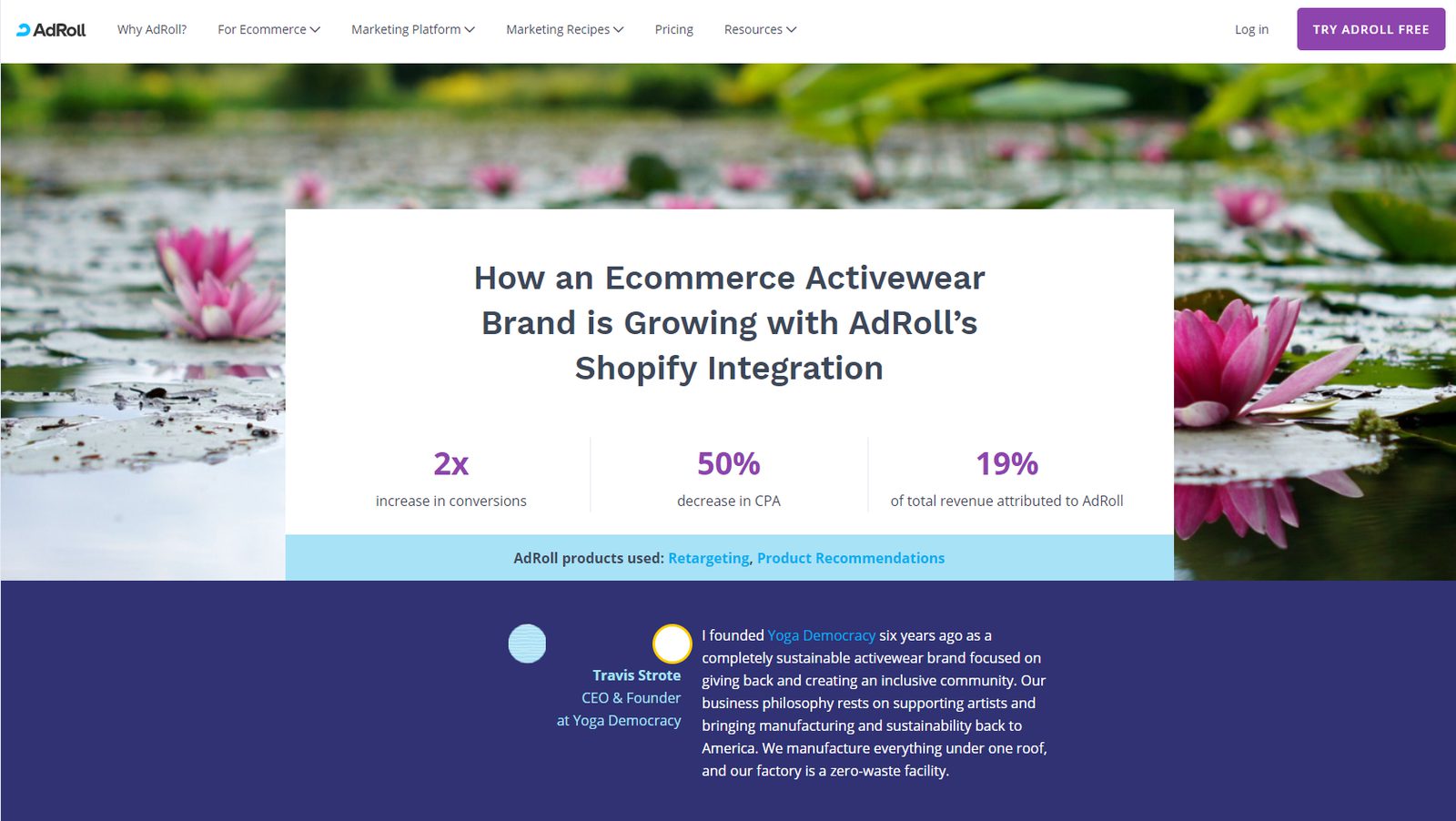
Look at these highlights:
- 200% increase in conversions
- 50% reduction in CPA
- 19% of total revenue attributed to AdRoll
These are metrics you’d love to show any potential customer. The case study goes into detail about how they built an effective remarketing campaign, including cart recovery emails and ads.
Because of the detail, you can classify this as an implementation case study.
8. Influencer marketing case study: Trend and WarbyParker
This influencer marketing case study from Warby Parker and Trend showcases how you can use influencer marketing even with a limited budget.

The “Wearing Warby” campaign was centered around showcasing influencers wearing Warby Parker glasses in their everyday life.
From mundane tasks like eating breakfast to artists creating a new masterpiece — it showcased Warby Parker’s products in use and made the brand more approachable for influencers’ followers.
This is another third-person case study, as it doesn’t go into much detail beyond the results.
9. Customer experience case study: App Annie and Coca-Cola
In this case study, Greg Chambers, the director of innovation for Coca-Cola, explains what App Annie brings to the table.
Instead of specific numbers and metrics, it focuses on the big-picture benefits that App Annie has on Coca-Cola’s customer experience.
The video interview format is also perfect for driving trust with potential customers.
Again, this is a typical third-person case study that you see a lot in the marketing world.
10. SaaS case study: Asana and Carta
Of course, it’s not just agencies and advertising platforms that need to master the use of case studies in digital marketing.
Let’s explore an example of a case study outside the marketing industry, in this case specifically for B2B marketers.
Asana is a project management platform that helps companies make their workflows more efficient.
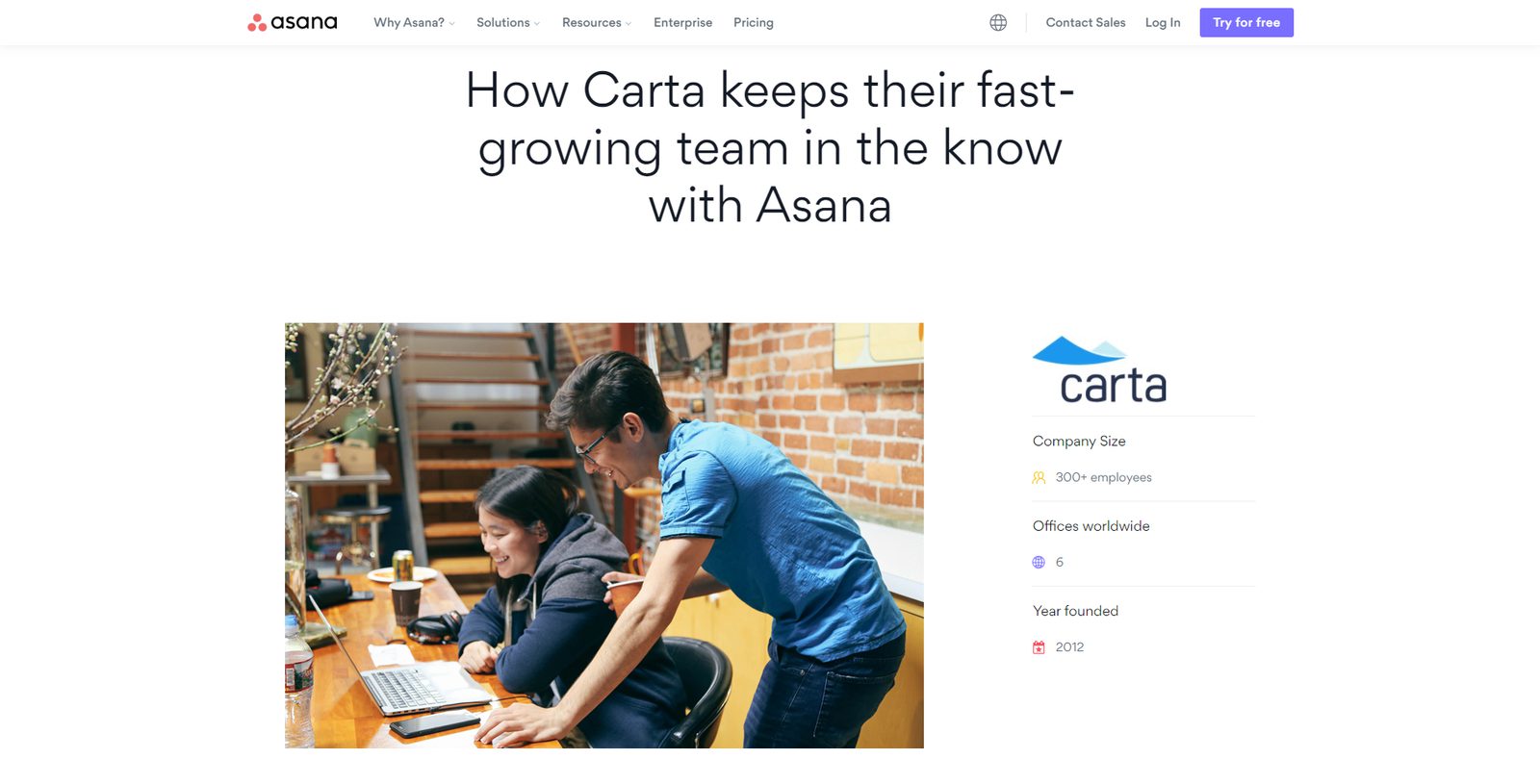
It’s a good example of a case study that focuses more on the lived experience and less on the metrics.
This is a third-person case study that is closer to a client interview or testimonial, which is a good option if it’s hard to quantify improvements with metrics.
Best practices: How to use case studies in your own marketing campaigns
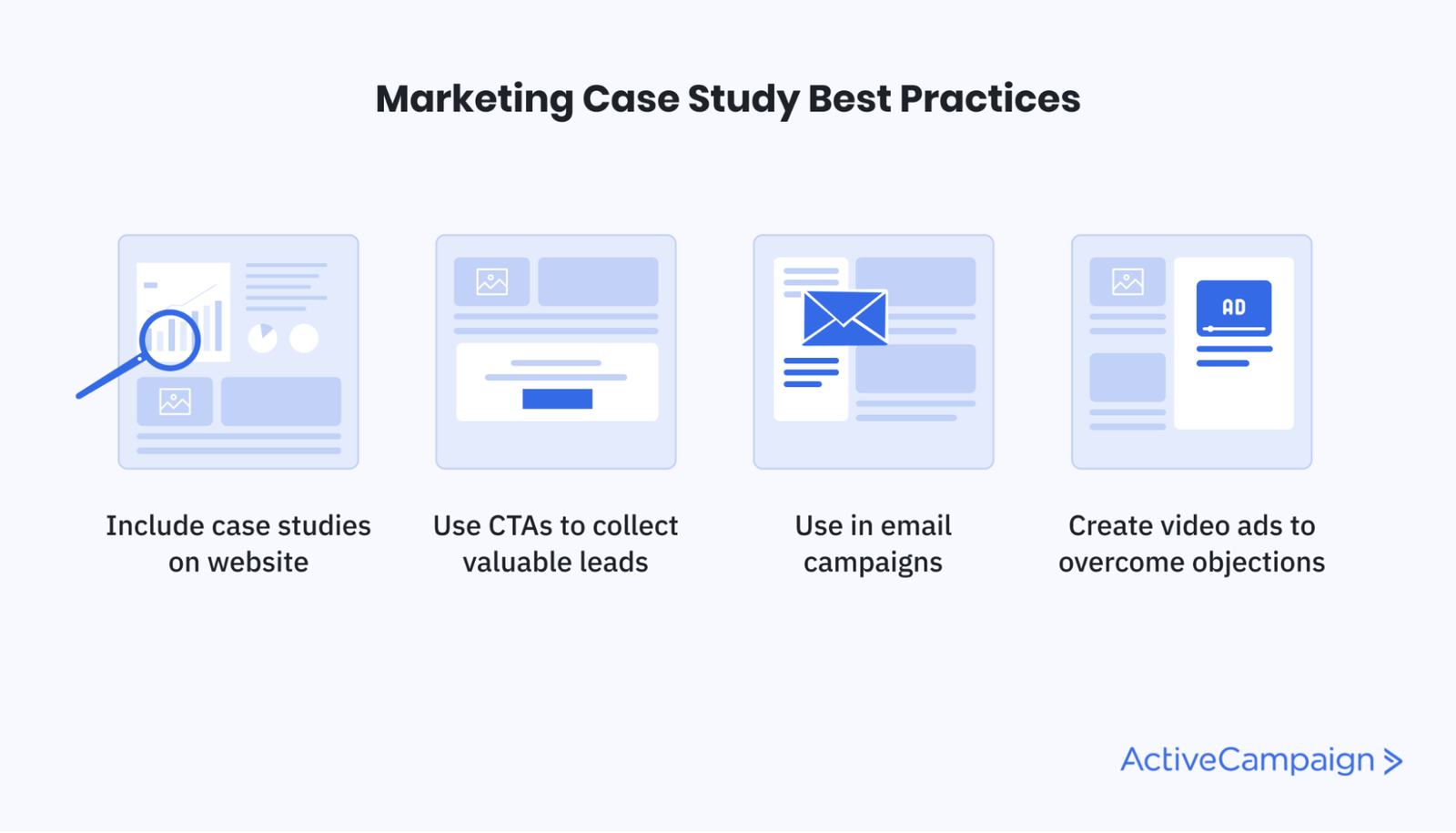
In this section, you’ll learn best practices to help you maximize the value of case studies in your own marketing campaigns.
Let’s look at four steps you can take to effectively use case studies.
Include a dedicated case study/customer stories page on your website
Most companies with a successful online presence have one of these pages. Emulate the top competitors in your industry by creating an improved version of their pages.
You can also add a case studies section to your resources page or blog.
Build CTAs into your case study pages
The chances are low that a random Googler will make it to your case studies. Most likely, it’s someone who thinks they might need your product.
So don’t be afraid to include calls to action throughout your case study pages.
Share case studies as part of your email marketing campaigns
Email marketing is hands-down the best channel for nurturing potential needs. That means you should always use case studies and customer success stories in your campaigns.
But it’s important that it doesn’t feel too promotional. Instead, share the unique steps they took to ensure success to deliver value, not just pitch.
Use case study video ads to overcome objections
When you’re thinking about buying a product, it’s easy to talk yourself out of it.
“It’s too expensive.” “It won’t work for me.” There are a lot of excuses and objections out there.
A case study video can be a powerful tool to overcome these objections in potential buyers.
Don’t overlook case studies when you’re planning your next marketing campaign. Towards the bottom end of the funnel, in stages like decision and action, they’re a powerful marketing tool.
When used right, case studies will help you fill your sales pipeline and provide your sales team with qualified leads.
Conclusion
Hopefully, the examples in this article taught you how you can use case studies in social media, email, and content marketing strategy to further your business goals.
You should also have learned how to use case studies to sell your company’s expertise.
If you want to grow your business, it’s crucial to learn from the people who have gone before you. In marketing, trying to learn all principles from scratch through trial and error would be a costly mistake.
If you’re ready to take advantage of marketing automation and email marketing tools that help similar businesses generate ROIs of 20x or higher, start your ActiveCampaign trial today.









